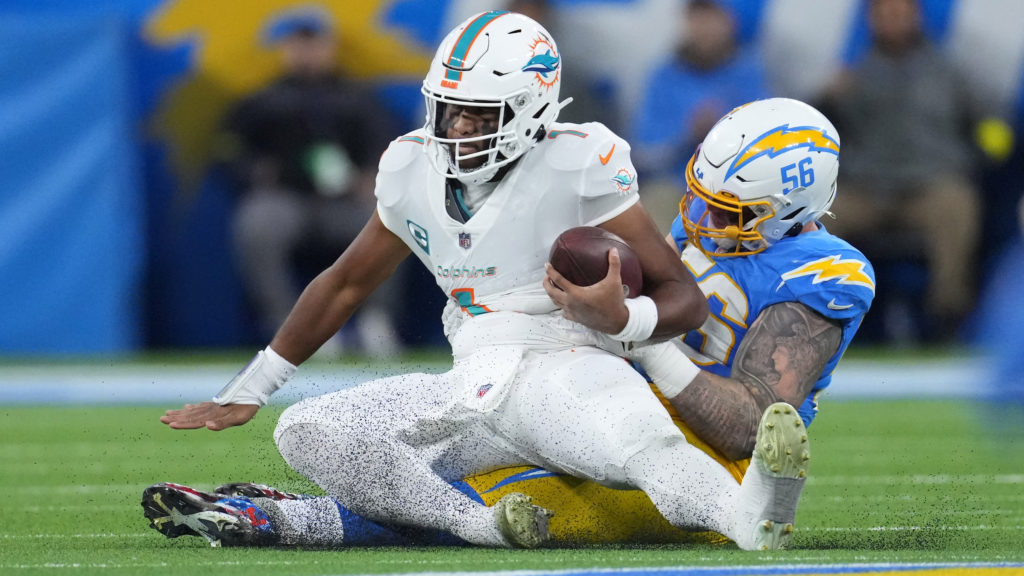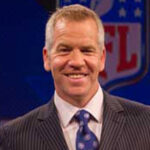Analysis
12/15/22
9 min read
Pre-Snap Read: How Dolphins Can Help Tagovailoa and Disarm Alarms

There’s no reason to sound the alarm, but let’s acknowledge that the Miami Dolphins’ offensive performance the last two weeks has been … alarming.
And confusing, because for the better part of three months, Tua Tagovailoa looked like a Pro Bowl quarterback, and Mike McDaniel’s offense was an often-explosive, consistently efficient passing machine.
But in the span of seven days, the Tagovailoa-McDaniel combo was overwhelmed against the 49ers in Santa Clara before hitting an even lower point last Sunday night against the Chargers in Los Angeles.
It should be noted that the 49ers have the best defense in the NFL, and they routinely make offenses a lesser version of themselves. And one horrible game is acceptable – almost expected – in a 17-game season. The low point of a season has to happen sometime, but what do you do when that point happens to a playoff-caliber team, in December, in consecutive weeks?
I’ve spent time this week watching Tagovailoa and the Dolphins’ last two games, working to stay in that objective evaluation space between optimism and panic, with a goal of identifying what went wrong, and spinning it forward: What area of their recent failures is most concerning for their playoff push, and which parts of how the Niners and Chargers beat them can be repeated by their upcoming opponents?
Defensive Adjustments
After three months of Tagovailoa, Tyreek Hill and Jaylen Waddle driving the Dolphins' surgical passing game through the middle of the field at the short-to-intermediate range, defenses have taken note, and are proceeding accordingly. As former NFL cornerback Samari Rolle articulated earlier this week on The 33rd Team, the Chargers played the Dolphins’ wideouts with outside leverage, forcing Miami to throw inside, where linebackers and safeties were waiting.
They also had their corners play with a physicality against Hill and Waddle that we haven’t seen much this year. It was a gamble, one that most teams – because of Miami’s perimeter speed – haven’t been willing to take.
I went back to my notes from my Week 3 Pre-Snap Read column that focused on Miami’s game against Buffalo. In watching their Week 2 win over Baltimore, where Tagovailoa was 36-of-50 for 469 yards and six touchdowns, the word I found most in those notes was “cushion.” The corners, weary of Hill and Waddle’s speed, routinely lined up 6-10 yards off of them. It makes sense, conceding that much space before the snap is the ultimate sign of respect to a receiver’s speed. It announces that Priority 1 is to not let the receiver run by you, which those two can do as well as any tandem in the league.
But while the cushion can prevent the big play, it also allows unimpeded releases off the line. And when the play call asks the receiver to run some type of route less than 20 yards downfield, he is allowed to go screaming into that space, unaltered, and as fast as he’d like to the exact spot drawn up.
It puts McDaniel in a position of strength, dialing up plays from the heart of his wheelhouse. He has routinely leveraged the fear that Hill and Waddle instill in a defense, and gone to work on the cushion coverage that has come with it.
Chargers coach Brandon Staley was refreshingly forthright about this after his team beat Miami Sunday night. He noted that teams have played scared against the Dolphins, uber-worried about their speed. He said you have to get close to them, challenge them and be physical. Lining up close to the Dolphins’ wide receivers and jamming them at the line serves two real purposes, if done well: It prevents them from achieving top speed so quickly, and ideally reroutes them, veering them off schedule at least a little.
Playing with Rhythm
The worst part about this for any quarterback is it throws off the timing of the quick-passing game. For Tagovailoa, who followed up his poorest game of the season against the 49ers (18-of-33, 245, 2 TD, 2 INT) with an even worse one at the Chargers (10-of-28, 145 yards, 1 TD, 0 INT), it also induces part of his game with which he struggles. He is at his best when he can throw it right now. He’d much rather throw it sooner than later. He’s an excellent rhythm passer, especially from the shotgun, with a play call that starts with a little play-action fake to a back. His ball handling is super, his fakes are effective, and he has a naturally quick and sturdy setup.
When he’s allowed to play with this rhythm, he executes the short-to-intermediate passing game beautifully. But when the defense does something to throw off that timing – in this case by being physical with the receivers at the line of scrimmage – he’s thrown out of his comfort zone. He becomes hesitant, inaccurate, and less effective.
And this is the part of Miami’s two-game offensive slide that Tagovailoa needs to own, and is potentially most concerning for the Dolphins’ playoff push. His response to the in-play tumult that inevitably presents itself a handful of times each game – the kind that comes from the pocket collapsing as well as his receivers being jammed – just wasn’t good. It was consistently poor, actually. When his initial look wasn’t open, and even more so when the pocket began to collapse around him, he often looked out of sorts.
There’s a moment for quarterbacks, more like a split second, that happens often throughout a game, that ends up defining if his game was a success or a failure. One of two things happen in that instant when it doesn’t look like anyone is open and the pocket is caving in: 1) The quarterback concedes with a sack or a throwaway, or 2) does something that reminds you why quarterback is known as the toughest position in sports – he instinctively slides right or left, slightly steps up, quickly retreats, or finds another way to evade the rush for a second.
It can be slight and graceful or strong and powerful, but the result is the same: He finds an open window for his feet and his body, as well as a place to go with the ball, and somehow delivers it on target.
It’s a super-high bar to set, to expect consistent success, or at least find it occasionally, in that pocket predicament. But the quarterbacks who are still playing in mid-January will admirably be adept at it and consistently do it well. And in the last couple games, Tagovailoa’s responses in that situation just haven’t gotten the Dolphins the results they need.
NFL defenses are quick to learn and quick to emulate. There will play more physical against Hill and Waddle, more four-man rush with seven dropping toward the middle of the field, fully aware that is Miami’s desired space. More efforts to throw off Tagovailoa’s pocket timing and rhythm passing are coming. That’s a given. How he handles it is Miami’s great unknown.
With all of that said – and with the Dolphins' two-game struggles being such a popular discussion all week – all is potentially well in Miami. They are 8-5, after all, and in the driver's seat for the postseason. And when you take a step back from the recent failures and look at the whole season, there’s a body of work that should instill more confidence than doubt.
Offensive Corrections
To help get their quarterback and their overall production moving back in that direction, I’m hoping to see three things. First, take a little pressure off Tagovailoa by running the ball a little more. The Dolphins don’t need to become a run-first team, but they’d be well served to lean into it a little more.
In their last two games, that have both basically been offensive debacles, their run-game numbers haven’t been all bad: 27 attempts for 125 yards. That’s nearing five yards per attempt. The problem is Tagovailoa has had 61 passing attempts in that time. Ten more runs and 10 fewer passes would have served them well the last two weeks, and that kind of ratio would help them going forward, starting Saturday evening in Buffalo.
They could take a cue from the Lions here. Detroit isn’t making a living running the ball, but their commitment to doing so 25-30 times a game keeps their pass offense on schedule, and has provided an unheralded assist to Jared Goff’s success.
And while Miami is adding more Raheem Mostert, I’ll take more Mike Gesicki, too. The tight end has been targeted only three times in this 0-2 run, with zero catches. Hill and Waddle only become bigger threats if Gesicki resurfaces as a reliable option.
Finally, I think they’d be well served to bring back more of the behind-the-line-of-scrimmage, quick-hitting perimeter passing game they featured early in the season. In the Week 2 win over the Ravens, roughly a quarter of Tagovailoa’s 36 completions were basically extensions of the running game, delivered to Hill or Waddle immediately after the snap, allowing them to show off their speed and elusiveness, and giving the defense one more reason to worry about them. The Dolphins getting away from this part of their passing game – and most of their running game – and the losses the last two weeks go hand-in-hand.
As for all the worry about Tagovailoa, it’s legit after the depths he and the offense dipped to in losses to the 49ers and Chargers. But also legit are the previous eight games he started and finished this season that produced an 8-0 record, a span where he threw 19 touchdowns to only two interceptions. The majority of his work this season has been Pro-Bowl caliber, and occasionally MVP-worthy.
Seeing which direction Tagovailoa’s game goes in the final four games of the regular season – specifically how he responds to the pocket chaos that’ll inevitably show up each game – is one of the home-stretch stories I’m most looking forward to watching.







